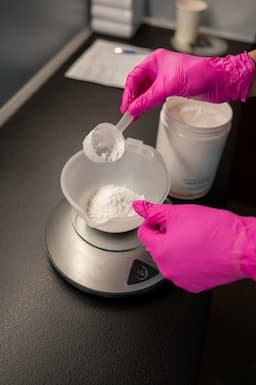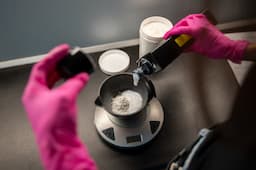Home / Products/ Hydrogen Peroxide

Hydrogen Peroxide
Product Specification
SYNONYMS
MOLECULAR WEIGHT
CAS NUMBER
CHEMICAL FORMULA
HS CODE
DENSITY
MELTING POINT
BOILING POINT
VISCOSITY
SHELF LIFE
TYPICAL PROPERTIES
APPEARANCE
Chemical Name
Industry
Application of Hydrogen Peroxide
- Disinfectant and Antiseptic: Hydrogen peroxide is commonly used as a disinfectant, antimicrobial, and antiseptic for cleaning wounds and cuts. It helps prevent infection by killing bacteria.
- Hair Bleaching: It is used as a hair bleach or lightening agent in the cosmetic industry.
- Teeth Whitening: Hydrogen peroxide is an ingredient in some teeth-whitening products, where it acts to break down and remove stains on teeth.
- Cleaning Agent: In households and industries, hydrogen peroxide is used as a cleaning agent for surfaces, fabrics, and equipment.
- Water Treatment: Hydrogen peroxide is employed in water treatment processes to eliminate organic impurities and improve water quality.
- Rocket Propellant: In certain rocket propulsion systems, hydrogen peroxide can be used as a propellant.
- Textile Industry: It is used in the textile industry for bleaching and treating fabrics.
- Paper Industry: Hydrogen peroxide is used in both chemical and mechanical pulping processes to remove lignin (the natural polymer that gives wood its brown colour).
WHY ELCHEMY?
At Elchemy, we go beyond conventional solutions. Our in-house team of tech experts has developed a cutting-edge platform to streamline operations, providing seamless digital tracking and access to documents, ensuring peace of mind for our customers. With warehouses strategically located worldwide and DDP shipments for door delivery, we ensure swift and efficient logistics, supplemented by necessary certifications and compliances.
But it's not just about transactions; it's about relationships. We mitigate credit risk, foster transparency, and prioritize customer satisfaction above all else. Whether you're in pharmaceuticals, agriculture, or manufacturing, Elchemy is your trusted partner in navigating the complexities of the chemical industry, transforming challenges into opportunities, one happy customer at a time.
Product Specification
SYNONYMS
MOLECULAR WEIGHT
CAS NUMBER
CHEMICAL FORMULA
HS CODE
DENSITY
MELTING POINT
BOILING POINT
VISCOSITY
SHELF LIFE
TYPICAL PROPERTIES
APPEARANCE
Chemical Name
Industry
Application of Hydrogen Peroxide
- Disinfectant and Antiseptic: Hydrogen peroxide is commonly used as a disinfectant, antimicrobial, and antiseptic for cleaning wounds and cuts. It helps prevent infection by killing bacteria.
- Hair Bleaching: It is used as a hair bleach or lightening agent in the cosmetic industry.
- Teeth Whitening: Hydrogen peroxide is an ingredient in some teeth-whitening products, where it acts to break down and remove stains on teeth.
- Cleaning Agent: In households and industries, hydrogen peroxide is used as a cleaning agent for surfaces, fabrics, and equipment.
- Water Treatment: Hydrogen peroxide is employed in water treatment processes to eliminate organic impurities and improve water quality.
- Rocket Propellant: In certain rocket propulsion systems, hydrogen peroxide can be used as a propellant.
- Textile Industry: It is used in the textile industry for bleaching and treating fabrics.
- Paper Industry: Hydrogen peroxide is used in both chemical and mechanical pulping processes to remove lignin (the natural polymer that gives wood its brown colour).
WHY ELCHEMY?
At Elchemy, we go beyond conventional solutions. Our in-house team of tech experts has developed a cutting-edge platform to streamline operations, providing seamless digital tracking and access to documents, ensuring peace of mind for our customers. With warehouses strategically located worldwide and DDP shipments for door delivery, we ensure swift and efficient logistics, supplemented by necessary certifications and compliances.
But it's not just about transactions; it's about relationships. We mitigate credit risk, foster transparency, and prioritize customer satisfaction above all else. Whether you're in pharmaceuticals, agriculture, or manufacturing, Elchemy is your trusted partner in navigating the complexities of the chemical industry, transforming challenges into opportunities, one happy customer at a time.
Get Your Quote Instantly! Contact Us Now!
Product FAQs
What are the main uses of Hydrogen Peroxide?
+
How does Hydrogen Peroxide act as a disinfectant?
+
Is hydrogen peroxide a bleach?
+
Can hydrogen peroxide be used to clean fruits and vegetables?
+
Is hydrogen peroxide flammable?
+
Related Products
Related Blogs

Why the Cosmetic Industry Relies on Hydrogen Peroxide for Hair Bleaching
Discover why the cosmetic industry relies on hydrogen peroxide for hair bleaching, how it works, its...

Bleach vs. Hydrogen Peroxide: The Truth About Safety, Strength, and Everyday Use
Bleach vs. hydrogen peroxide: Learn which is safer, stronger, and better for everyday cleaning, disi...

Top 7 Harmful Chemicals in Hair Dye — And How to Avoid Them
Discover the top 7 harmful chemicals in hair dye, their risks to your health, and safe alternatives ...

Alternatives to Rubbing Alcohol: Natural and Chemical Options Explained for Cleaning and Disinfection
Discover effective alternatives to rubbing alcohol for cleaning and disinfection. Compare hydrogen p...

Hydrogen Peroxide vs Rubbing Alcohol: Applications Across Healthcare and Industrial Sectors
Compare rubbing alcohol vs hydrogen peroxide for disinfection. Learn chemical differences, healthcar...

Hydrogen Peroxide vs. Isopropyl Alcohol: Which Disinfectant Suits Your Industrial Process?
In the hydrogen peroxide vs isopropyl alcohol debate, choosing the right one impacts safety, efficac...

How Speciality Chemicals Are Transforming India Into A Global Superpower?
Discover how specialty chemicals are propelling India's rise as a global superpower, driving innovat...

Water Treatment Chemicals to Ensure Safe Industrial Waste Water Disposal
Discover the key water treatment chemicals for safe industrial waste water disposal, their rising de...

Chemical Solutions and Their Top 10 Industrial Uses
Explore the top 10 industrial uses of chemical solutions in various industries.

The Role of Chemical Solutions in Food Processing and Manufacturing: Key Insights for Businesses
Learn the important role chemical solutions play in food processing and manufacturing, their advanta...

Hydrogen Peroxide for Water Treatment: How It Works and Its Benefits
Discover the uses of hydrogen peroxide for water treatment. Understand how it works, its advantages ...

Key Factors For Buying Chemicals in Bulk Quantities
What are the key factors for buying chemicals that you should keep in mind while going for bulk deal...
Product FAQs
What are the main uses of Hydrogen Peroxide?
+
How does Hydrogen Peroxide act as a disinfectant?
+
Is hydrogen peroxide a bleach?
+
Can hydrogen peroxide be used to clean fruits and vegetables?
+
Is hydrogen peroxide flammable?
+
Related Products
Related Blogs

Why the Cosmetic Industry Relies on Hydrogen Peroxide for Hair Bleaching
Discover why the cosmetic industry relies on hydrogen peroxide for hair bleaching, how it works, its...

Bleach vs. Hydrogen Peroxide: The Truth About Safety, Strength, and Everyday Use
Bleach vs. hydrogen peroxide: Learn which is safer, stronger, and better for everyday cleaning, disi...

Top 7 Harmful Chemicals in Hair Dye — And How to Avoid Them
Discover the top 7 harmful chemicals in hair dye, their risks to your health, and safe alternatives ...

Alternatives to Rubbing Alcohol: Natural and Chemical Options Explained for Cleaning and Disinfection
Discover effective alternatives to rubbing alcohol for cleaning and disinfection. Compare hydrogen p...

Hydrogen Peroxide vs Rubbing Alcohol: Applications Across Healthcare and Industrial Sectors
Compare rubbing alcohol vs hydrogen peroxide for disinfection. Learn chemical differences, healthcar...

Hydrogen Peroxide vs. Isopropyl Alcohol: Which Disinfectant Suits Your Industrial Process?
In the hydrogen peroxide vs isopropyl alcohol debate, choosing the right one impacts safety, efficac...

How Speciality Chemicals Are Transforming India Into A Global Superpower?
Discover how specialty chemicals are propelling India's rise as a global superpower, driving innovat...

Water Treatment Chemicals to Ensure Safe Industrial Waste Water Disposal
Discover the key water treatment chemicals for safe industrial waste water disposal, their rising de...

Chemical Solutions and Their Top 10 Industrial Uses
Explore the top 10 industrial uses of chemical solutions in various industries.

The Role of Chemical Solutions in Food Processing and Manufacturing: Key Insights for Businesses
Learn the important role chemical solutions play in food processing and manufacturing, their advanta...

Hydrogen Peroxide for Water Treatment: How It Works and Its Benefits
Discover the uses of hydrogen peroxide for water treatment. Understand how it works, its advantages ...

Key Factors For Buying Chemicals in Bulk Quantities
What are the key factors for buying chemicals that you should keep in mind while going for bulk deal...















